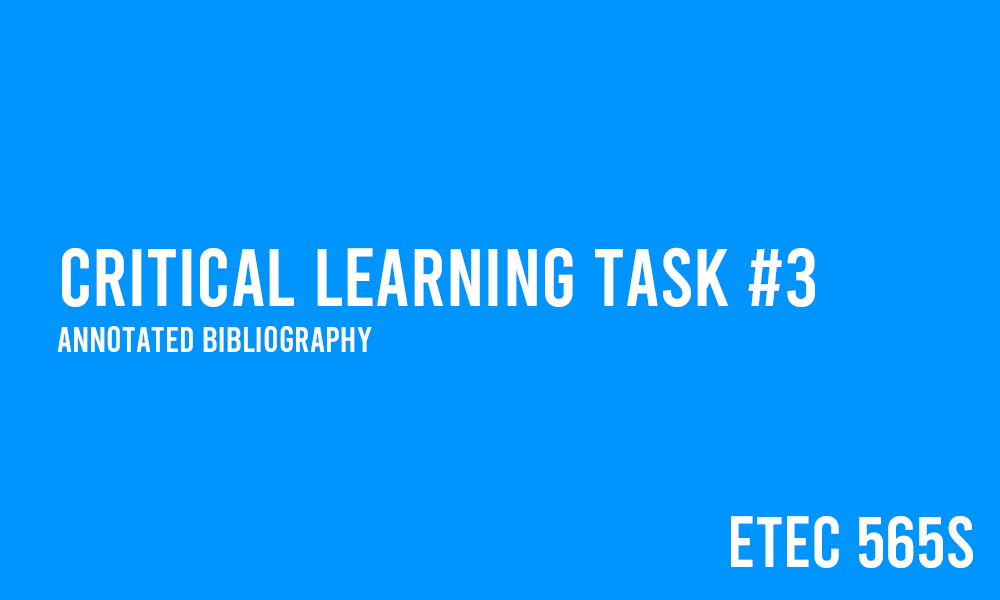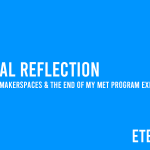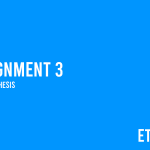Annotated Bibliography #1
Hughes & Morrison’s (2014) research investigates adolescents’ learning and their creation of digital texts to engage with social justice issues. The authors wanted to see the impact of giving students a voice through critical digital literacies (CDL) to provide possible solutions and changes that they could make in their own communities. They conclude that combining young adult fiction with a CDL approach empowers students to engage with each other and their community in ways that goes beyond learning.
The authors conducted a three-year qualitative case study involving five classes of middle school students and their teachers in an area near Toronto, Ontario (Hughes & Morrison, 2014). Students participated in inquiry-based learning activities to create their own digital texts, engage in literature circles, and communicate with their peers in face-to-face meetings and online. Data gathered by the authors included information collected through classroom observations, interviews, and from the students’ own digital texts (Hughes & Morrison, 2014).
The findings of Hughes & Morrison are reasonable as CDL aligns with modern curriculums and competencies. Community building and collaboration are key aspects of CDL, and the use of Ning and other digital tools enabled the students to take charge of their learning. However, the findings have some limitations. The technologies used for CDL may vary across classrooms and may affect the results. The students’ prior knowledge and socio-economic background may also influence their success, which is not fully considered as a limitation of the study. Hughes & Morrison’s (2014) research shares the importance of CDL and how it can inspire students to promote change in their communities.
Reference Hughes, J. & Morrison, L. (2014). At the intersection of critical digital literacies, YAL and literature circles. ALAN Review, 42(1), 35-43.
Annotated Bibliography #2
Love et al. (2020) conducted research to question the health and safety risks that can be present in makerspace environments for students, with a focus on those with disabilities. The authors offer guidance for makerspace instructors and users on how to make makerspaces accessible for all through appropriate planning, implementation, and active supervision. The article concludes that instructors should work with all stakeholders to ensure that makerspaces are as inclusive and safe as possible through various design, legal, and instructional considerations.
Legally, makerspace instructors must do their due diligence to lessen the risks to all users through proper education and instruction. They must also consider the security of the building so that materials and tools cannot be stolen. The design and layout of the space should be inclusive of all, including those with limited mobility. Finally, instructors should be accommodating to students and help provide different modifications so that access is equitable.
The authors followed a qualitative approach as they relied on experiences and thoughts from other sources to shape their recommendations instead of relying on numerical data. This approach allowed them to gather information from different sources to create a comprehensive guide to inclusive and safe makerspaces.
The article by Love et al. (2020) is an important read for makerspace instructors. It offers useful information to consider in makerspaces, to ensure they are inclusive. However, it could be more impactful if the information was presented as a resource that could easily be used to evaluate a makerspace, such as a checklist. The recommendations are also limited by the fact that makerspaces are student-driven and unpredictable, which means some of the suggestions may not apply to all student projects.
Reference Love, T.S., Roy, K.R., & Marino, M.T. (2020). Inclusive makerspaces, fab labs, and STEM labs. How can instructors make appropriate accommodations and modifications while maintaining a safer teaching and learning environments for ALL students and themselves? Technology and Engineering, 79(5), 23-36.






